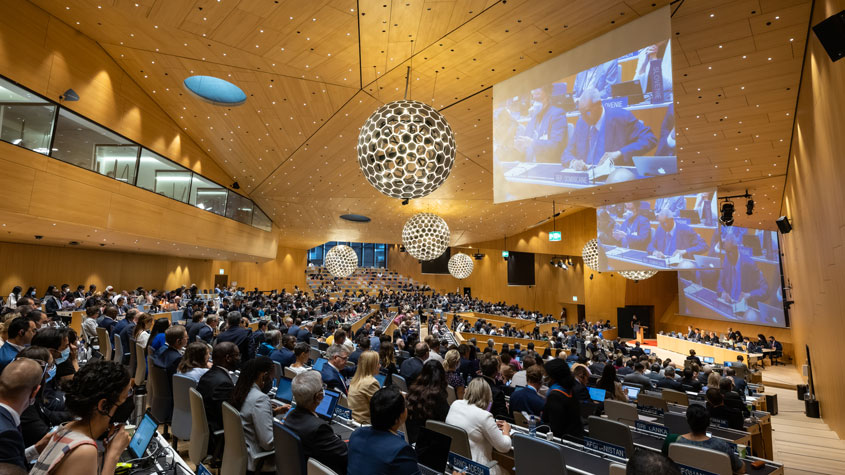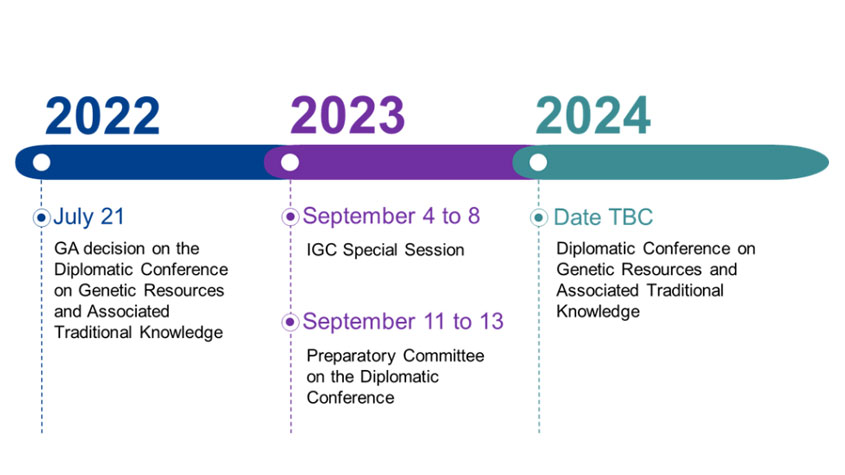
Un accord international sur la propriété intellectuelle, les ressources génétiques et les savoirs traditionnels connexes est-il enfin à portée de main?
Wend Wendland, directeur de la Division des savoirs traditionnels de l’OMPI et secrétaire du Comité intergouvernemental de la propriété intellectuelle relative aux ressources génétiques, aux savoirs traditionnels et au folklore de l’OMPI (IGC)
In a dramatic development July 2022, WIPO member states decided to fast-track negotiations on genetic resources and associated traditional knowledge by convening a Diplomatic Conference to conclude an international agreement on these matters no later than 2024. This step-change development, welcomed by many countries, is also revitalizing discussions on traditional knowledge more broadly and traditional cultural expressions/expressions of folklore. These exciting developments come after many years of intensive negotiations and mounting concerns about how they would evolve.

A Diplomatic Conference is a high-level meeting, where representatives of member countries come together to finalise and adopt an international treaty or convention. Countries and regional organizations that sign up to the treaty would then integrate its provisions into their national laws.
Successful conclusion of a diplomatic conference would bring to a close a long, complex, and often frustrating negotiation and would launch a new phase of work at WIPO on these issues. The ups and downs of these negotiations, spanning more than two decades, are outlined in a WIPO Magazine article published in February 2022. That article expands on the political, legal, regulatory and economic benefits of such an agreement and the broader work of the WIPO Intergovernmental Committee (IGC), in which the negotiations are taking place.
How the prospect of a diplomatic conference came into sight
At the 2022 session of WIPO’s annual General Assembly (GA), member states took a decision to convene two diplomatic conferences; one on genetic resources and associated traditional knowledge and one on a design law treaty to harmonize the formalities associated with acquiring design rights. The decision resulted from discussions on a proposal by the African Group of countries. However, game-changing developments in relation to the handling of matters at the GA 2022, played a significant role in enabling the decision to be taken by consensus, as outlined below.
Unpacking the GA’s decision
The IGC, which works on IP issues surrounding traditional knowledge, traditional cultural expressions and genetic resources, had met in June 2022, under its 2022-2023 mandate and work program. As required by the GA 2021, it submitted a factual report with recommendations to the GA 2022.
The report provided details of two IGC sessions held earlier in 2022 on genetic resources in which negotiations had stalled on the IGC’s principal negotiating text, a draft Consolidated Document Relating to Intellectual Property and Genetic Resources. Many (although not all) members favoured the text of an international legal instrument prepared by a former chair of the IGC, Ian Goss, under his own responsibility, the so-called Chair’s Text, as the basis of future work.
The expectation, at GA 2022, was that the IGC’s report would simply be noted with support expressed for the Committee’s continued work. Instead, the GA convened the diplomatic conference and stated that the Chair’s Text would serve as the basis for that negotiation.
Two countries formally disassociated themselves from the decision. A few others expressed their misgivings, but decided not to block the consensus.
A game-changing development in GA 2022 played a significant role in enabling the decision to be taken “by consensus.” While discussing another agenda item, member states had opted to vote, instead of relying on the traditional practice of consensual decision-making. Moving forward, exercising the option to vote may affect intergovernmental decision-making at WIPO on a range of issues.
The journey to the Diplomatic Conference
In preparation for the Diplomatic conference, a preparatory committee will meet from September 11 to 13, 2023, to establish the necessary modalities of the conference, including the venue, dates and rules of procedure. It will also approve the “basic proposal” for the administrative and final provisions of the treaty.
On the substance of the negotiation itself, the IGC will meet in a Special Session ahead of the preparatory committee, from September 4 to 8, 2023, to “further close any existing gaps to a sufficient level.” These meetings will take place at WIPO’s headquarters in Geneva, Switzerland, and will be open to accredited observers in line with established practice.
The GA 2022 decided that the Chair’s Text referred to above will constitute the substantive articles of the “basic proposal”. The basic proposal is the draft text to be considered by the Diplomatic Conference. However, the preparatory committee will also incorporate into that text “such further agreements of the IGC as are reached […] with the understanding that any Member State and the Special Delegation of the European Union may make proposals at the Diplomatic Conference.”
Timeline for the journey to the Diplomatic Conference

In the lead up to the Special Session and the preparatory committee, some member states are likely to meet among themselves to prepare and coordinate their negotiating positions. Given the technical nature of the subject matter, it is expected that experts from capitals, especially those from patent offices, will participate in these meetings.
To assist members and observers, a series of publications and other background materials, prepared by the IGC Secretariat, are available online.

The substantive issues
Genetic resources include medicinal plants, agricultural crops and animal breeds.
While genetic resources as they occur in nature are not directly protectable as IP, inventions developed using them are eligible for protection, most often through a patent. Genetic resources are often used in modern scientific research. As such, patented inventions may be based on a genetic resource.
Some genetic resources are associated with traditional knowledge through their use and conservation by Indigenous Peoples and local communities, often over generations. This traditional knowledge is sometimes used in scientific research and may, therefore, contribute to the development of a protected invention.
At the same time, beyond the world of IP, genetic resources and their associated traditional knowledge are subject to access and benefit-sharing (ABS) arrangements as set out in the Convention on Biological Diversity (1992), its Nagoya Protocol (2010) and other international agreements.
The high-level policy conundrum
Modern life sciences research, including through the use of genetic resources and traditional knowledge, offers humanity great benefits. However, many countries have been concerned that patents are granted for inventions that are based on genetic resources and their associated traditional knowledge, but that do not fulfill patentability requirements, such as novelty, inventiveness or industrial applicability. The granting of such “erroneous patents”, it is argued, facilitates the misappropriation of genetic resources and their associated traditional knowledge. This is referred to colloquially as “biopiracy.”
How then can the patent system help scientists, businesses and public sector research institutions realize the immense benefits of scientific research while simultaneously protecting the interests of biodiversity-rich countries, Indigenous Peoples, local communities and the broader scientific community?

What’s up for negotiation?
Many argue that a new disclosure requirement in patent law would help to achieve this balance. But what is the scope and, indeed, the rationale for such a new requirement? And what are the arguments against it?
Transparency through the disclosure of a description of inventions is a defining feature of the patent system. Under current patent law, in order to obtain patent protection for any invention, it is necessary, among other things, to disclose sufficiently detailed technical information about it. From society’s viewpoint, such disclosure is critical to promote scientific and technological progress and further innovation. This is one of the primary justifications for the patent system.
The proposal at the heart of the upcoming diplomatic conference is that applicants seeking patents for inventions that are based on genetic resources and associated traditional knowledge should include certain additional information, as part of the patent application. This includes information about the source or origin of the genetic resources and associated traditional knowledge.
At present, such information does not normally need to be disclosed in a patent application, as it is generally not relevant to determining the patentability of an invention.
Arguments in favor of an additional disclosure requirement
Proponents argue that an additional disclosure requirement would increase legal certainty, transparency and efficiency within the patent system. For example, it would, help patent examiners identify relevant prior art and thereby reduce the risk of granting patent rights for inventions that do not meet the requirements of novelty and inventive step.

They also argue that such a disclosure obligation will make it possible to monitor the contribution of genetic resources and associated traditional knowledge to patentable inventions. Since some countries have legislation which requires prior informed consent and benefit-sharing arrangements to be agreed before accessing a resource and related knowledge, it will help ensure that such knowledge and resources are used with the permission of the countries and/or communities from which they originate, enabling them to benefit in some way from the resulting inventions.
They argue that new disclosure obligations may prevent misappropriation and promote the fair and equitable sharing of benefits between users and providers of genetic resources and associated traditional knowledge. Holders include biodiversity-rich countries and Indigenous Peoples and local communities, while users are those with the modern technologies to exploit the scientific and commercial potential of these resources.
At present, more than 30 countries , including a mix of developing and developed countries, have adopted, or are in the process of adopting, some form of this kind of additional disclosure requirement in their national laws. The WIPO publication entitled Key Questions on Patent Disclosure Requirements for Genetic Resources and Traditional Knowledge examines and compares these national provisions.
What the opponents are saying
Opposing views, however, claim that such a new disclosure obligation would impede innovation, with inventors turning increasingly to secrecy to protect their innovations. They claim it would create uncertainty for patent applicants, investors and the R&D sector and would be burdensome, expensive and time-consuming for patent applicants and patent offices to implement. They also argue that the patent system is not designed to implement objectives or goals external to the IP system (such as ABS objectives). Those opposing new disclosure requirements advocate for the greater use of databases – see below.
What the Chair’s Text says
The Chair’s Text proposes that such a disclosure requirement should form a mandatory part of patent law. Why? To enhance the efficacy, transparency and quality of the patent system, and prevent patents from being granted erroneously for inventions that are not novel or inventive with regard to genetic resources and associated traditional knowledge.
The Chair’s Text sets out the proposed content of the requirement, as well as its subject matter scope, exceptions and limitations, temporal and geographic/spatial scope, sanctions for non-compliance, relationship with other instruments and other matters. An informal summary of the Chair’s Text sums up the main provisions.
The Chair’s Text also proposes that databases of information about genetic resources and traditional knowledge should be established and made accessible to patent examiners to reduce the risk of patents being granted erroneously. Databases are another tool that some argue can help to address the high-level policy conundrum identified earlier.
The decision by GA 2022 to accelerate negotiations on genetic resources and associated traditional knowledge is a step-change in the work of the IGC.
IGC negotiations on traditional knowledge and traditional cultural expressions
While the decision by GA 2022 does not directly relate to on-going negotiations on traditional knowledge and cultural expressions - these continue as per the IGC’s current mandate - it has boosted interest in these negotiations. Indeed, the current IGC Chair, Lilyclaire Bellamy, is already consulting on a Chair’s Text to address the complexities of the IP and traditional knowledge/ cultural expressions nexus. This text could well provide fresh impetus to the IGC’s work in this area.
Complementary activities decided by the IGC
In June 2022, the IGC mandated a new series of complementary virtual activities to address, first, information systems, registers and databases of genetic resources, traditional knowledge and traditional cultural expressions, and second, possible disclosure requirements. These activities were launched in late 2022, and will continue through 2023. They span both the genetic resources/ associated traditional knowledge and traditional knowledge/ cultural expressions tracks of the IGC’s work.
Various IGC sessions are preceded by ad hoc experts’ meetings. In addition, the February 2023 session of the IGC will be preceded by an Indigenous Expert Workshop.
These activities continue in spite of the GA’s decision. The Traditional Knowledge Division ensures that these activities are coordinated and feed substantively into the various tracks, including the new diplomatic conference track.
A final word
The decision by GA 2022 to accelerate negotiations on genetic resources and associated traditional knowledge is a step-change in the work of the IGC. The decision itself, while dramatic, is procedural throat-clearing – much substantive work lies ahead. Born of understandable frustration with the slow progress made in the IGC over the years, this unanticipated jolt has brought into sight the exciting possibility of bringing these long-standing negotiations to a successful conclusion.
Acknowledgements: Edward Kwakwa, Begoña Venero, Shakeel Bhatti and Fei Jiao, Global Challenges and Partnerships Sector, WIPO
Related articles
- International negotiations on Indigenous knowledge to resume at WIPO: a view of the journey so far and the way ahead
- Protecting Indigenous knowledge: a personal perspective on international negotiations at WIPO
Le Magazine de l’OMPI vise à faciliter la compréhension de la propriété intellectuelle et de l’action de l’OMPI parmi le grand public et n’est pas un document officiel de l’OMPI. Les désignations employées et la présentation des données qui figurent dans cette publication n’impliquent de la part de l’OMPI aucune prise de position quant au statut juridique des pays, territoires ou zones concernés ou de leurs autorités, ni quant au tracé de leurs frontières ou limites territoriales. Les opinions exprimées dans cette publication ne reflètent pas nécessairement celles des États membres ou du Secrétariat de l’OMPI. La mention d’entreprises particulières ou de produits de certains fabricants n’implique pas que l’OMPI les approuve ou les recommande de préférence à d’autres entreprises ou produits analogues qui ne sont pas mentionnés.